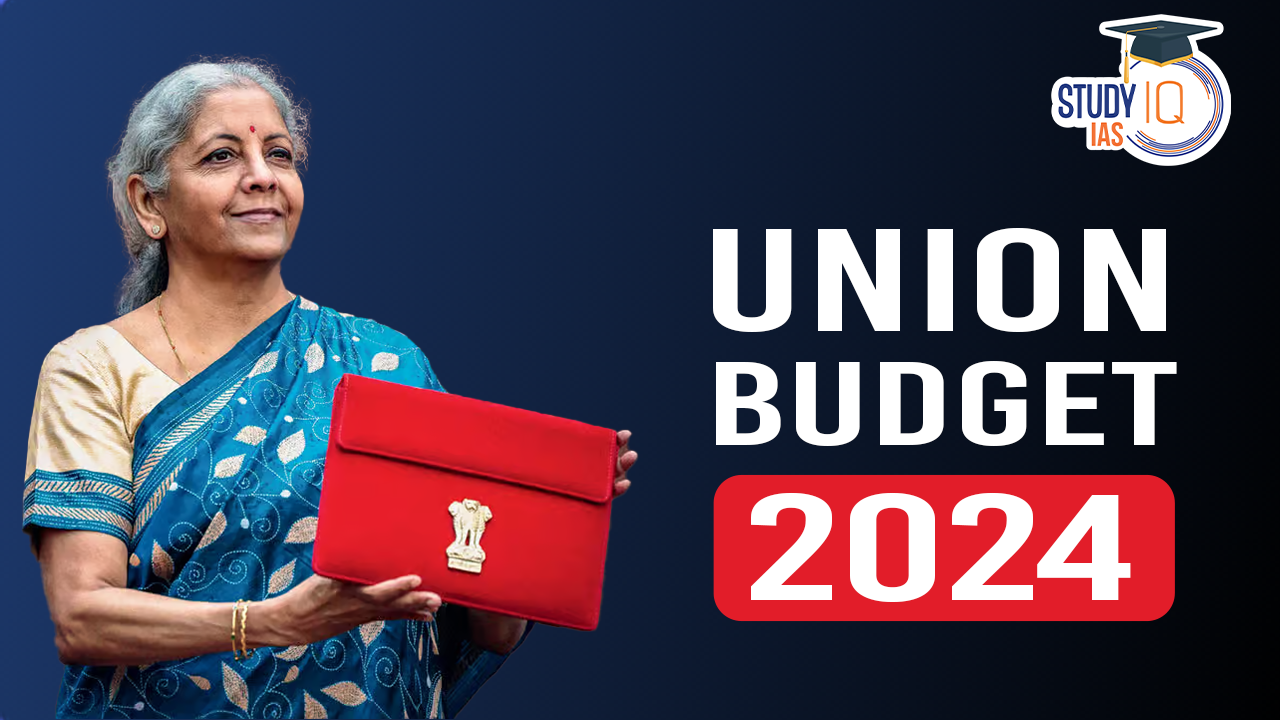Table of Contents
Finance Minister Nirmala Sitharaman presented her seventh consecutive Union Budget on July 23, 2024. This Budget is seen as the action plan for the Modi 3.0 government, outlining a roadmap for India’s development over the next five years. With a focus on employment, tax relief, and various sectoral improvements, the Budget 2024-25 is eagerly anticipated by all.
Union Budget 2024
Key Highlights of Union Budget 2024
The Union Budget is a critical component of the UPSC syllabus, especially for the Prelims and Mains stages. Here are the key highlights and important pointers from the Union Budget 2024, presented by Union Finance Minister Nirmala Sitharaman. This budget, under the Modi 3.0 government, focuses on the poor (‘Garib’), youth (‘Yuva’), farmers (‘Annadata’), and women (‘Nari’). The Budget emphasizes nine priorities: productivity & resilience in agriculture, employment & skilling, inclusive human resource development & social justice, manufacturing & services, urban development, energy security, infrastructure, innovation, R&D, and next-generation reforms.
Agriculture
- Allocation: ₹1.52 Lakh Crore for agriculture and allied sectors.
- New Varieties: 109 high-yielding and climate-resilient varieties of 32 field and horticulture crops.
- Natural Farming: 1 crore farmers to be initiated into natural farming; 10,000 Bioinput research centers to be established.
- Digital Public Infrastructure (DPI): DPI for Agriculture to be implemented in three years with Kisan Credit cards in five states.
Employment and Skilling
- Allocation: ₹1.48 lakh crore for education, employment, and skill.
- Schemes: Five schemes for employment benefiting 4.1 crore youth with an outlay of ₹2 lakh crores.
- Scheme A: Direct benefit transfer of one month’s salary for first-time job seekers.
- Scheme B: Job creation in manufacturing.
- Scheme C: Additional employment in all sectors.
- Education Loans: ₹10 lakh loans for higher education with annual interest subvention of 3%.
- Women: Measures for higher participation in the workforce, including hostels, creche facilities, and market access for SHG enterprises.
Human Resource Development and Social Justice
- Purvodaya: Development of eastern India, including Bihar, Jharkhand, West Bengal, Odisha, and Andhra Pradesh.
- Projects: Amritsar Kolkata Industrial Corridor, expressways, and infrastructure projects.
Manufacturing and Services
- MSMEs: Financing, regulatory changes, technology support, credit guarantee schemes, and self-financing guarantee fund.
- Internship: 1 crore youth internships in top companies over 5 years.
- Industrial Parks: Development of investment-ready “plug and play” industrial parks in 100 cities.
Urban Development
- PM-AWAS Yojana Urban 2.0: Investment of ₹10 lakh crore for 1 crore urban poor and middle-class families.
- Water Supply and Sanitation: Projects in collaboration with states and multilateral development banks.
Energy Security
- Nuclear Energy: Partnership with the private sector for Bharat Small Reactors and Modular Reactors.
- Solar Power: PM Surya Ghar Muft Bijli Yojana for rooftop solar plants.
- Pumped Storage Policy: Promotion of pumped storage projects for electricity storage.
- Advanced Ultra Super Critical Thermal Power Plants: Development of indigenous technology for 800 MW plants.
Infrastructure
- Allocation: ₹11.11 lakh crore for capital expenditure.
- Pradhan Mantri Gram Sadak Yojana (PMGSY): Phase IV for rural connectivity.
- Irrigation and Flood Control: Financial support for projects like Kosi-Mechi intra-state link.
Innovation and R&D
- Anusandhan National Research Fund: Operationalization for basic research and prototype development.
- Space Economy: Venture capital fund of ₹1000 crore to expand the space economy.
Next Generation Reforms
- Land Reforms: ULPIN for all lands, digitization of cadastral maps, establishment of land registry.
- Labour Reforms: Integration of e-shram portal with other portals for ease of compliance.
- Climate Finance: Development of a taxonomy to enhance capital availability for climate adaptation.
Tax-Related Proposals
- Income Tax Act, 1961: Comprehensive review for simplification and reduction of disputes.
- Angel Tax Abolished: Boost for startups by removing the tax on investors.
- Security Transactions Tax: Increased to 0.02% for futures and 0.1% for options.
Basics of the Union Budget
The Union Budget, technically called the Annual Financial Statement under Article 112 of the Constitution, outlines the government’s financial health. It includes estimates of revenue and expenditure for the coming financial year and details of the government’s borrowing requirements.
Important Budget Documents:
- Annual Financial Statement (AFS)
- Demands for Grants (DG)
- Finance Bill
Key Terms:
- Revenue Budget: Consists of revenue receipts (tax and non-tax revenues) and revenue expenditures.
- Capital Budget: Includes capital receipts (loans) and capital expenditures (acquisition of assets).
- Fiscal Deficit: Difference between total revenue receipts plus non-debt capital receipts and total expenditure.
- Demands for Grants: Estimates of expenditure required to be voted by the Lok Sabha.
- Money Bill: Deals with taxes, borrowing, and expenditure from the Consolidated Fund of India.
- Finance Bill: Details the imposition, abolition, and regulation of taxes proposed in the Budget.
Pre-Budget Activities and Market Reactions
Cabinet Approval
Earlier in the day, the Cabinet, chaired by Prime Minister Narendra Modi, approved the Union Budget 2024. This approval is a crucial step before the Finance Minister presents the Budget in Parliament.
Market Movements
Ahead of the Budget presentation, the Sensex opened 220 points higher at 80,740, while Nifty was up by 59 points. However, the markets experienced some jitters, with Sensex and Nifty trading in negative territory just before the Budget announcement.
Impact of Budget 2024
In the 2024 Union Budget, Finance Minister Nirmala Sitharaman announced several changes to customs duties and proposed adjustments to support various sectors. Here’s a summary of the key points:
Items Becoming Cheaper
| Category | Items | Details |
|---|---|---|
| Healthcare | Cancer Drugs | Reduction in customs duty aims to make life-saving medications more affordable. |
| Healthcare | Medical X-ray Machines | Lowering duties could enhance access to diagnostic equipment in healthcare facilities. |
| Technology | Mobile Phones and Chargers | Duty cuts expected to reduce retail prices, benefiting consumers and potentially boosting demand. |
| Energy | Equipment Using Solar Cells and Panels | Encourages the adoption of renewable energy by reducing the cost of solar technology. |
| Aquaculture | Fish and Shrimp Feed | Decrease in costs could benefit the industry by making feed more affordable. |
| Consumer Goods | Leather Goods | Lower customs duties may reduce production costs and retail prices for leather products. |
| Consumer Goods | Footwear | Reduction could benefit both consumers and the domestic footwear industry. |
| Manufacturing | Textiles | Lower duties could reduce costs for manufacturers and consumers. |
| Jewelry | Gold, Silver, Platinum Making Charges | Decrease in making charges could lower the overall cost of jewelry. |
Items Becoming Costlier
| Category | Items | Details |
|---|---|---|
| Agriculture/Industry | Ammonium Nitrate | Increase in duty may impact costs for agriculture and industries using ammonium nitrate. |
| Advertising/Marketing | PVC Flex Banners | Higher duties might increase costs for businesses relying on PVC banners for marketing. |
| Telecommunications | Imported Telecom Equipment | Increased costs could affect telecommunications infrastructure and consumer prices. |
Major Announcements and Initiatives
First-Time Worker Scheme
To encourage employment, the government will provide one month’s wage to all first-time workers in all sectors. This initiative aims to support new entrants into the workforce and boost job creation across the country.
Natural Farming Initiative
The government plans to introduce one crore farmers to natural farming over the next two years. This initiative aims to promote sustainable agricultural practices and reduce reliance on chemical inputs.
Focus on Key Sectors
The Budget prioritizes several key sectors, including:
- Agriculture and natural farming
- Employment and skilling
- Human resources and social justice
- Manufacturing and services
- Urban development
- Energy security
- Infrastructure
- Innovation, research, and development
- Next-generation reforms
Prime Minister’s Statement
Prime Minister Narendra Modi expressed confidence in the Budget, stating that it would present a strong action plan for India’s development. He emphasized that the government’s guarantees would reach the common man and highlighted the significance of the Modi 3.0 government’s first Budget in its third term.
Union Budget 2024 UPSC
Budget 2024, presented by Finance Minister Nirmala Sitharaman, focuses on employment, tax relief, and various sectoral improvements. With initiatives aimed at boosting job creation, supporting the middle class, and promoting sustainable agricultural practices, the Budget outlines a comprehensive roadmap for India’s development over the next five years. Stay tuned for further updates and detailed analysis of the Union Budget 2024.


 New Phase of Operation Chakra to Combat ...
New Phase of Operation Chakra to Combat ...
 Soyuz Aircraft: History, Design and Sign...
Soyuz Aircraft: History, Design and Sign...
 Topological Materials: The Future of Qua...
Topological Materials: The Future of Qua...





















